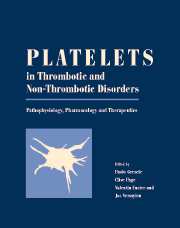Book contents
- Frontmatter
- Contents
- List of contributors
- Editors' preface
- PART I PHYSIOLOGY
- 1 History of platelets
- 2 Production of platelets
- 3 Morphology and ultrastructure of platelets
- 4 Platelet heterogeneity: physiology and pathological consequences
- 5 Platelet membrane proteins as adhesion receptors
- 6 Dynamics of the platelet cytoskeleton
- 7 Platelet organelles
- 8 Platelet receptors for thrombin
- 9 Platelet receptors: ADP
- 10 Platelet receptors: prostanoids
- 11 Platelet receptors: collagen
- 12 Platelet receptors: von Willebrand factor
- 13 Platelet receptors: fibrinogen
- 14 Platelet signalling: GTP-binding proteins
- 15 Platelet phospholipases A2
- 16 Roles of phospholipase C and phospholipase D in receptor-mediated platelet activation
- 17 Platelet signalling: calcium
- 18 Platelet signalling: protein kinase C
- 19 Platelet signalling: tyrosine kinases
- 20 Platelet signalling: cAMP and cGMP
- 21 Platelet adhesion
- 22 The platelet shape change
- 23 Aggregation
- 24 Amplification loops: release reaction
- 25 Amplification loops: thromboxane generation
- 26 Platelet procoagulant activities: the amplification loops between platelets and the plasmatic clotting system
- 27 Platelets and chemotaxis
- 28 Platelet–leukocyte interactions relevant to vascular damage and thrombosis
- 29 Vascular control of platelet function
- PART II METHODOLOGY
- PART III PATHOLOGY
- PART IV PHARMOLOGY
- PART V THERAPY
- Afterword: Platelets: a personal story
- Index
- Plate section
29 - Vascular control of platelet function
from PART I - PHYSIOLOGY
Published online by Cambridge University Press: 10 May 2010
- Frontmatter
- Contents
- List of contributors
- Editors' preface
- PART I PHYSIOLOGY
- 1 History of platelets
- 2 Production of platelets
- 3 Morphology and ultrastructure of platelets
- 4 Platelet heterogeneity: physiology and pathological consequences
- 5 Platelet membrane proteins as adhesion receptors
- 6 Dynamics of the platelet cytoskeleton
- 7 Platelet organelles
- 8 Platelet receptors for thrombin
- 9 Platelet receptors: ADP
- 10 Platelet receptors: prostanoids
- 11 Platelet receptors: collagen
- 12 Platelet receptors: von Willebrand factor
- 13 Platelet receptors: fibrinogen
- 14 Platelet signalling: GTP-binding proteins
- 15 Platelet phospholipases A2
- 16 Roles of phospholipase C and phospholipase D in receptor-mediated platelet activation
- 17 Platelet signalling: calcium
- 18 Platelet signalling: protein kinase C
- 19 Platelet signalling: tyrosine kinases
- 20 Platelet signalling: cAMP and cGMP
- 21 Platelet adhesion
- 22 The platelet shape change
- 23 Aggregation
- 24 Amplification loops: release reaction
- 25 Amplification loops: thromboxane generation
- 26 Platelet procoagulant activities: the amplification loops between platelets and the plasmatic clotting system
- 27 Platelets and chemotaxis
- 28 Platelet–leukocyte interactions relevant to vascular damage and thrombosis
- 29 Vascular control of platelet function
- PART II METHODOLOGY
- PART III PATHOLOGY
- PART IV PHARMOLOGY
- PART V THERAPY
- Afterword: Platelets: a personal story
- Index
- Plate section
Summary
Introduction
The vascular endothelium is a dynamic cellular interface between the blood and subendothelial tissue and is critical for the maintenance of blood flow and hemostasis. The endothelium releases substances (Fig. 29.1) that play an important role in the modulation of vascular tone and permeability, as well as blood fluidity. These substances affect vascular tone by causing both vasodilation [prostaglandin I2 (PGI2), nitric oxide (NO), and endothelium- derived hyperpolarizing factor (EDHF)] and vasoconstriction [thromboxane A2 (TXA2) and endothelin (Et-1)], with the interaction between these two processes ultimately determining the tone of the vessel. In addition to modulating vascular tone, substances released from the endothelium affect platelet adhesion and aggregation. Nitric oxide inhibits platelets adhesion and aggregation, and PGI2 inhibits platelet aggregation.
Abnormal endothelial responses (endothelial dysfunction) or frank damage to or denudation of the endothelium promotes a prothrombotic state by reducing antiplatelet factors and by inducing adhesion molecule expression. Furthermore, endothelial dysfunction may be involved in the pathogenesis of several cardiovascular disorders, including atherosclerosis, diabetes mellitus, essential hypertension, hypercholesterolemia, and hyperhomocysteinemia.
In this chapter we will review the control of normal endothelial function, with specific emphasis on antiplatelet effects of substances released from the endothelial cell. We will also review the consequences of endothelial dysfunction, giving specific examples in several disease states.
- Type
- Chapter
- Information
- Platelets in Thrombotic and Non-Thrombotic DisordersPathophysiology, Pharmacology and Therapeutics, pp. 432 - 456Publisher: Cambridge University PressPrint publication year: 2002
- 3
- Cited by



